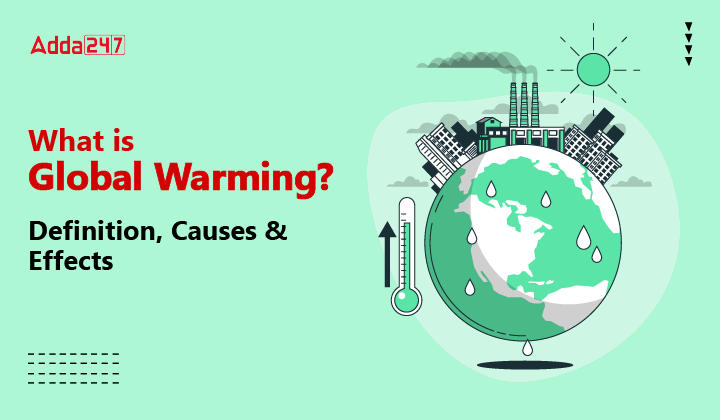Table of Contents
Global Warming is the most pertinent issue that has plagued the present and future of Life on Earth. It is the gradual rise in the earth’s temperature is brought on by the greenhouse effect, which is caused by elevated amounts of carbon dioxide, CFCs, and other pollutants. As it is such a crucial topic of discussion, it is commonly asked in various Government teaching Exams every year. Therefore candidates preparing for the Teaching Exam 2023 must read through the following article and get ready to answer a wide variety of questions in their upcoming exams.
UGC NET Study Notes for Paper 1
What is Global Warming?
The phenomenon of a slow and gradual rise in temperature close to the earth’s surface is known as global warming. Over the last century or two, this pattern has been observed. The earth’s climatic conditions have been altered by this unprecedented change. Although the idea of global warming is still up for debate, scientists have presented evidence to support the idea that the earth’s temperature is steadily increasing.
Global warming has a number of causes that are harmful to people, plants, and animals. These factors could be a result of human activity or could be natural. Understanding the harmful effects of global warming is crucial for tackling these problems.
Causes of Global Warming
There are man-made as well as natural causes that lead to global warming. It is essential to learn in detail about the various man- made and natural causes of Global Warming to be able to understand the challenges, issues and possible solutions to reduce Global Warming. A detailed study of the same has been highlighted below.
Man-made causes
The cause that has been created by humankind is called man-made causes. There are many man-made causes resulting in global warming. The consistent practice of these causes for decades and centuries has led to the correct situation. In the following section, all the man-made causes have been enumerated.
Deforestation
The primary source of oxygen is plants. They maintain environmental balance by absorbing carbon dioxide and exhaling oxygen. For a variety of domestic and commercial uses, forests are being destroyed. This has caused an imbalance in the environment, which has resulted in global warming.
Chlorofluorocarbon
Humans have been introducing CFCs into the environment through the excessive use of air conditioners and freezers, which has an impact on the ozone layer in the atmosphere. The ozone layer shields the surface of the earth from the sun’s harmful ultraviolet rays. By causing the ozone layer to thin and make space for ultraviolet light, CFCs have raised the earth’s temperature.
Heavy usage of automobile
Even over extremely short distances, using a car produces a variety of gaseous pollutants. When fossil fuels are burned in automobiles, a lot of carbon dioxide and other poisons are released into the atmosphere, thereby raising the temperature.
Industrial Development
The onset of industrialization has resulted in a dramatic rise in earth’s temperature. The earth’s temperature is rising as a result of the industries’ damaging emissions.
According to a 2013 report from the Intergovernmental Panel on Climate Change, the global temperature rose by 0.9 degrees Celsius between 1880 and 2012. When compared to the pre-industrial mean temperature, the rise is 1.1 degrees Celsius.
Rise in population
More individuals breathing is equivalent to more people in the population. As a result, the atmospheric concentration of carbon dioxide, the main gas responsible for global warming, rises.
Natural causes
The cause that arises due to constant natural phenomena is called natural causes. Natural causes generally contribute to the climate change without the influence of humankind. Check out the natural causes resulting in global warming that have been enumerated below.
Volcanoes
One of the primary natural causes of global warming is volcanoes. Volcanic eruptions release smoke and ash into the sky, which has a severe impact on the climate.
Forest Fires
Forest fires and blazes produce a lot of smoke that contains carbon. Global warming results from the emission of these gases into the atmosphere, which raises the earth’s temperature.
Permafrost
Under the surface of the Earth, there is permafrost, which is frozen soil that has been trapped in ambient gases for a long time. It can be found in glaciers. Gases are released back into the atmosphere as and when the permafrost melts.
Water Vapor
One type of greenhouse gas is water vapor. As the earth’s temperature rises, more water evaporation from water bodies occurs and stays in the atmosphere, contributing to global warming.
Global Warming – Effects
There are several adverse effects of global warming that have hindered the conventional functioning of the Earth over the years. These effects have now become persistent and the impact of these effects is tremendous. In the following section, all the adverse effects of Global Warming are mentioned in detail.
Excessive rise in temperature
The temperature of the world has risen dramatically as a result of global warming. The earth’s temperature has increased by 1 degree since 1880. As a result, there has been an increase in glacier melting, which has raised the sea level. The after-effects for coastal areas could be catastrophic.
Climatic changes
Climatic conditions have changed as a result of global warming. There are both droughts and floods in some regions. The cause of this climatic imbalance is global warming.
Increase in deaths
The average death toll typically rises due to an increase in floods, tsunamis, and other natural calamities. Additionally, such occurrences may lead to the spread of diseases that may endanger human life. Global warming leads to a change in the patterns of heat and humidity. This has led to the movement of mosquitoes that carry and spread diseases.
A threat to the ecosystem
Coral reefs have been impacted by global warming, which may result in the extinction of plants and animals. The fragility of coral reefs has gotten worse as a result of the rise in global temperatures.
Loss of natural habitat
Innumerable plants and animals lose their habitats as a result of worldwide climate change. The creatures in this situation are forced to leave their native habitat, and many of them even go extinct. This is yet another significant effect of climate change on biodiversity.
Download UGC NET Paper 1 Study Notes PDF
Here we are providing UGC NET Paper 1 Study Notes PDF in below link. Download Global Warming Study Notes PDF through clicking on below link.
Download Global Warming – Definition, Causes & Effects Study Notes PDF



 UGC NET Philosophy Syllabus 2025 PDF Dow...
UGC NET Philosophy Syllabus 2025 PDF Dow...
 UGC NET Commerce Syllabus 2025 PDF Downl...
UGC NET Commerce Syllabus 2025 PDF Downl...
 PMMMNMTT for NEP 2020, Check details Her...
PMMMNMTT for NEP 2020, Check details Her...














